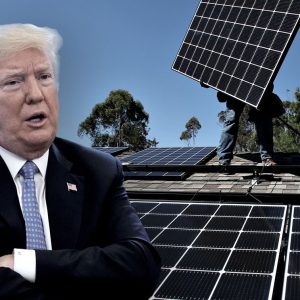President Donald Trump’s move to slap tariffs on imported solar equipment is the biggest blow to the renewables industry yet.
Apparently, the United States proposed solar tariff has imposed duties of about 30 per cent on solar systems made abroad, a decision that threatens to ultimately collapse the $28 billion industry that heavily relies on imported parts for at least 80 per cent of its supply.
This move has been consistent with the president’s long-standing opposition to the renewable energy industry in favour of traditional energy sources.
What does this mean for the US Solar market?
The mere threat of solar tariffs has put solar developers in disarray in the past few months, as some have been forced to hoard panels and/or stall projects in anticipation of rocket-high costs. The Solar Energy Industries Association has projected massive job losses in tens of thousands in a sector with 260,000 employees.
The latest action by Mr. Trump on tariffs undermines the economics of renewable energy. Last year, President Trump’s administration pulled the U.S. out of the international Paris climate agreement, ditched Obama-era regulations on power plants emissions and approved various tax reforms that hampered solar and wind projects financing. The recent measure on import taxes is certainly the most targeted attack on the renewables industry.
According to Hugh Bromley, a New York-based analyst at Bloomberg New Energy Finance, “developers may have to walk away from their projects,” stated in an interview before Trump’s announcement. “Some rooftop solar companies may have to pull out” of some states.
First Solar Inc., a U.S. solar panel manufacturer moved up 9 per cent to $75.20 within a few hours of trading in New York. Tempe, an Arizona-based panel maker stands to be the biggest beneficiaryof the solar tariff as costs of foreign panels are expected to rise. First Solar Company was not available to comment. The Energy Industries Association didn’t provide any response either.
Reason for solar tariff
In a statement on Monday, president Trump said the first 2.5GW of imported solar cells will be exempted from the new solar tariffs. He further approved a four-year tariffs program that begins at 30 per cent in the initial year, but drops gradually to 15 per cent.
The new duties are slightly lower than the 35 per cent rate recommended last October by the U.S. International Trade Commission after it discovered that panels from abroad were hurting domestic manufacturers.
The main reason for the tariffs is to increase the cost of cheap imports especially from Asia and ensure a level playing ground for those who manufacture the solar parts locally.
According to Trump, the latest action represents a step closer to making good his campaign promise of getting tougher on the no. 1 solar panel manufacturer—China.
President Trump’s trade issues were temporarily put on hold in 2017 as the White House channeled its energies towards tax reforms, but now it’s bringing the matter back to the fore: The controversy surrounding solar is one of the trade decisions that involve steel, washing machines and consumer electronics.
“It’s the first opportunity the president has had to impose tariffs or any sort of trade restriction,” Clark Packard, a trade policy expert at the R Street Institute in Washington, said ahead of the decision. “He’s kind of pining for an opportunity.”
Mr. Trump’s solar tariff decision comes just nine months after Suniva Inc., a liquidated U.S. based module maker with a Chinese majority owner, issued claim on import duties on solar panels and cells citing it had suffered “serious injury” from a market flooded with cheap solar panels manufactured in Asia. A few weeks later, the U.S. unit of SolarWorld AG, a Berman manufacturer came on board as a co-petitioner to add heft and back Suniva’s cause.
By the time of writing this post, Solarworld’s attorney couldn’t be reached for comment on these developments. In their submission, Suniva sought 32 cents per watt in import duties for panels sourced from abroad and a floor price of 74 cents per watt.
International reception to solar tariff
Even though Trump has great influence on the scope, size and duration of duties, the dispute at hand may take a different path with China and other affected countries like South Korea choosing to challenge Trump’s decision at the World Trade Organization which has once repulsed tariffs brought before it after they were imposed by the U.S.
According to Lewis Leibowitz, a trade lawyer based in Washington, the matter is likely to wind up with the WTO. “Nothing is very likely to stop the relief in its tracks,” he said before the decision. “It’s going to take a while.”
The solar sector may also take a long-shot by making an appeal to Congress.
“Trump wants to show he’s tough on trade, so whatever duties or quotas he imposes will stick, whatever individual senators or congressmen might say,” Gary Hufbauer, a Washington-based senior fellow based at the Peterson Institute for International Economics, wrote in an email before the president’s decision to move on a solar tariff.

